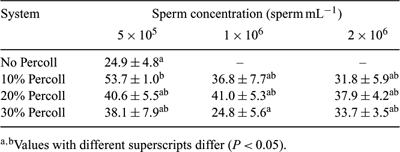305 INCREASED MONOSPERMIC PENETRATION OF PORCINE OOCYTES USING A VISCOUS IN VITRO FERTILIZATION SYSTEM
H. Men A B , W. Si A and J. K. Critser A BA Comparative Medicine Center, University of Missouri, Columbia, MO 65201, USA
B National Swine Resource and Research Center, University of Missouri, Columbia, MO 65201, USA
Reproduction, Fertility and Development 19(1) 268-268 https://doi.org/10.1071/RDv19n1Ab305
Submitted: 12 October 2006 Accepted: 12 October 2006 Published: 12 December 2006
Abstract
The high incidence of polyspermy remains a major problem in porcine IVF systems. The high number of sperm bound to the oocyte is one of the major causes for pathological polyploidy (Funahashi 2003 Reprod. Fertil. Dev. 15, 167–177). In this experiment, we tested the hypothesis that limiting the number of competent sperm able to participate in fertilization during IVF will result in a reduction in polyspermic penetration. Combinations of various sperm (3 levels) and Percoll concentrations (3 levels) were used in a modified Tris-buffered medium (mTBM) with 3% polyvinylpyrrolidone supplementation to find the optimal combination that could result in a significant reduction in polyspermy rate compared with that resulting from the current porcine IVF system (Abeydeera and Day 1997 Theriogenology 48, 537–544). In vitro-matured gilt oocytes (n = 844) were randomly allocated into 1 of 10 treatment groups in groups of 30. Motile sperm were selected from frozen–thawed samples by density gradient centrifugation using a discontinuous Percoll gradient consisting of 3 mL of 54% Percoll in PBS on top of 1 mL of 72% Percoll in a 15-mL conical tube at 600g for 15 min. After centrifugation, the supernatant was removed as much as possible without disturbing the sperm pellet. Sperm stock solutions were made in a manner that resulted in the desired final concentration of sperm when 5 µL of the sperm solution were added to 95 µL of fertilization medium. During IVF, the sperm stock solutions were placed at one side of an IVF droplet so that most sperm were trapped inside the viscous Percoll solution and only a limited number of sperm, with high progressive motility, were capable of fertilizing the oocytes. A group of oocytes fertilized using our standard IVF protocol with a sperm concentration of 5 × 105 sperm mL−1 in mTBM served as a control. Pronuclear formation after 12 h of fertilization was used to assess sperm penetration. The data from 3 replicates were analyzed by standard ANOVA procedures using the Statistical Analysis System (SAS Institute, Inc., Cary, NC, USA). The treatment group of 5 × 105 sperm mL−1 + 10% Percoll resulted in a significantly higher monospermy rate than the control or the treatment group of 1 × 106 sperm mL−1 + 30% Percoll (Table 1; P < 0.05). These data support the hypothesis that the polyspermy rate in a porcine IVF system can be reduced by limiting the number of competent sperm fertilizing the oocytes.

|
This project was supported by NIH U42 RR 018877.


